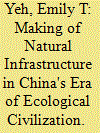|
|
|
Sort Order |
|
|
|
Items / Page
|
|
|
|
|
|
|
| Srl | Item |
| 1 |
ID:
178067


|
|
|
|
|
| Summary/Abstract |
Recent scholarship on the lived experiences of borderlands has foregrounded and theorized the pervasiveness of anxiety, violence, and lawlessness. While useful, these do not capture all of the ways in which borderland residents relate to diverse constellations of power. This paper examines the China (Tibet Autonomous Region) – Nepal borderland through the case of the Limi Valley, in the northwest corner of Nepal’s Humla district. Before 1959, the valley was considered part of Nepalese territory, yet its residents belonged administratively to the Tibetan government, an arrangement at odds with contemporary understandings of state territorial sovereignty. The non-postcolonial state formations of Nepal and China have created their own specific forms of border citizenship and overlapping sovereignties. The article shows how multiple sovereignties can stretch beyond state borders in unexpected ways by tracing how Limi Valley residents negotiate overlapping sovereignties of the Nepali and Chinese states, as well as the non-state sovereignty of the Tibetan government-in-exile. Furthermore, it demonstrates that these in turn overlap with a form of social sovereignty grounded in the community’s body of laws, codes, and practices, which are at once a historically sedimented trace of Limi’s governance before the nation-state, and a product of navigating political transformations. However, challenges to this social sovereignty, expressed through the idiom of statist law, have recently emerged. Whereas states typically exert sovereign power in borderlands by restricting mobility, some Limi villagers now selectively invoke state sovereignty through law to enable greater mobility.
|
|
|
|
|
|
|
|
|
|
|
|
|
|
|
|
| 2 |
ID:
192623


|
|
|
|
|
| Summary/Abstract |
Campaign-style environmental enforcement that involves the destruction of infrastructure has become increasingly common. Scholars have theorized such crackdowns as a form of bureaucratic control. These explanations are compelling, yet incomplete. This paper adopts an infrastructural lens to call attention to the fact of infrastructural demolition. I argue that the reduction of existing infrastructure to rubble is a way of clearing space for other kinds of infrastructure, specifically natural infrastructure, which has become central in the pursuit of ecological civilization. The creation of natural infrastructure requires calculative tools, which work to obscure the profoundly political nature of the natural infrastructure that they create through spatial zoning, ecological functional zoning and ecological conservation red lines (ECRLs). The article then scales down to two case studies of villages in post-earthquake Sichuan that are within ECRLs and designated for the function of providing ecosystem services. In both, infrastructure within scenic areas that was previously encouraged by the state and central to village livelihoods was suddenly destroyed following ecological civilization enforcement campaigns. The arrival of natural infrastructure marks a national-scale infrastructural time that promises a new future in which village-controlled scenic areas have no part, leading to a ruination of their imagined futures.
|
|
|
|
|
|
|
|
|
|
|
|
|
|
|
|
| 3 |
ID:
163342


|
|
|
|
|
| Summary/Abstract |
This article provides an introduction to a special collection of five articles showcasing the work of rising scholars in the geography and anthropology of Tibetan regions in China (Eveline Washul, Andrew Grant, Tsering Bum, Huatse Gyal and Duojie Zhaxi, published in Critical Asian Studies 50: 4 and Critical Asian Studies 51: 1). It contextualizes the authors’ contributions in the recent promotion of planned urbanization in Tibetan regions as the key to achieving the “Chinese Dream” under President Xi Jinping. The paper calls attention to these authors’ focus on Tibetan experiences of new urbanization policies and practices, as well as their less-appreciated entanglement with shifting education priorities. Providing brief summaries of each author’s case study and arguments, it points to the ways in which all five articles address the relationship between space and subjectivity, as well as the issue of constrained agency (versus simple notions of “choice”), in statist urbanization processes.
|
|
|
|
|
|
|
|
|
|
|
|
|
|
|
|
|
|
|
|
|